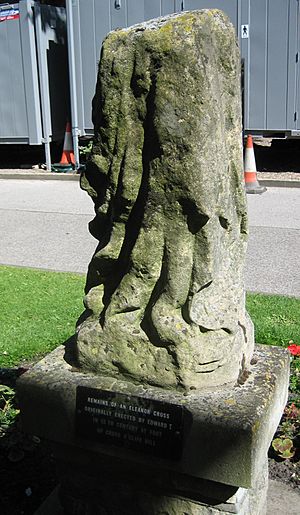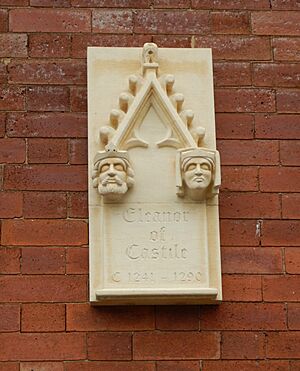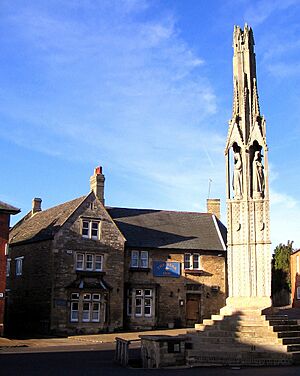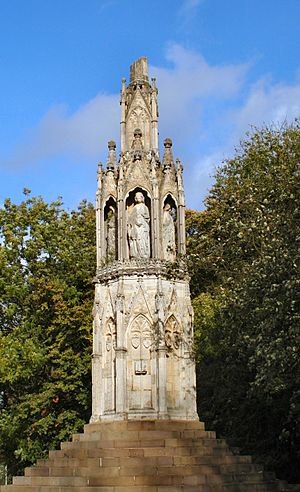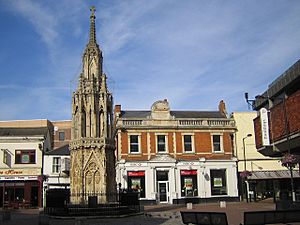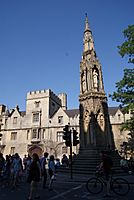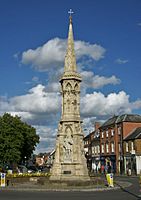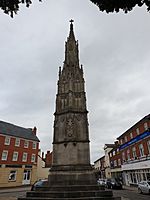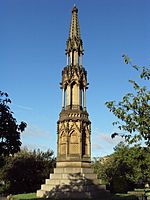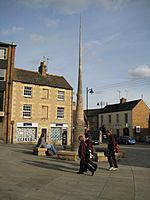Eleanor cross facts for kids
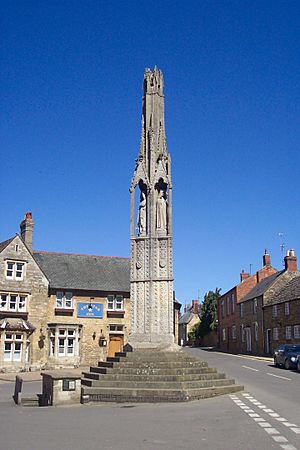
The Eleanor crosses were a group of twelve beautiful stone monuments. They were very tall and had crosses on top. These monuments were built in a line across the east of England.
King Edward I had them built between 1291 and 1295. He wanted to remember his wife, Eleanor of Castile, whom he loved very much. The King and Queen had been married for 36 years. Queen Eleanor was always by the King's side, even during his many travels.
She passed away in November 1290 in the East Midlands. The crosses were built to mark the places where her body rested each night. This was during her journey to Westminster Abbey near London, where she was buried.
The crosses stood in several towns: Lincoln, Grantham, and Stamford in Lincolnshire. There were also crosses in Geddington and Hardingstone in Northamptonshire. Other locations included Stony Stratford in Buckinghamshire, Woburn and Dunstable in Bedfordshire. Finally, there were crosses in St Albans and Waltham (now Waltham Cross) in Hertfordshire, and two in London: Cheapside and Charing (now Charing Cross).
Only three crosses are still mostly standing today: the ones at Geddington, Hardingstone, and Waltham Cross. The other nine have been lost, with only a few small pieces remaining. The biggest and most decorated of all twelve was the Charing Cross.
Contents
Why Were the Crosses Built?
A King's Love and Loss
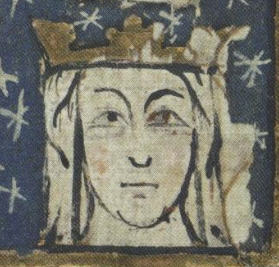
Queen Eleanor of Castile died on November 28, 1290. King Edward and Queen Eleanor truly loved each other. Edward was very devoted to his wife, just like his father had been. He stayed loyal to her throughout their marriage.
Her death made him very sad. To show his grief, he decided to build the twelve special monuments, known as Eleanor crosses. Each cross marked a place where her funeral procession stopped for the night.
The Queen's Final Journey
After her death, Queen Eleanor's body was taken to Lincoln, about 7 miles (11 km) away. Here, her internal organs (except her heart) were buried in Lincoln Cathedral on December 3.
Her other remains were then carried to London. This journey was about 180 miles (290 km) long and took 12 days. Her body was buried in Westminster Abbey on December 17. She was laid to rest at the feet of her father-in-law, King Henry III.
Her heart was buried separately on December 19. It was placed in the church of the Dominicans' priory in Blackfriars, London. Queen Eleanor and King Edward had supported this church a lot. Her heart was buried there with her young son, Alphonso, Earl of Chester, who had died in 1284.
Remembering the Queen
Special Monuments
Both of Eleanor's main burial sites had fancy monuments. The one at Westminster Abbey still exists. It has a life-sized statue of Eleanor made of gilded bronze. The monument at Lincoln Cathedral was destroyed in the 1600s. A new one was built in 1891, but not in the exact same spot. The monument for her heart at Blackfriars was also lost when the monasteries were closed down in 1538.
The Crosses as Memorials

The twelve crosses were built to mark the places where Eleanor's funeral procession stopped overnight. Records show that construction happened from 1291 to 1294. By 1294, most crosses were finished or nearly done. The last three, at Grantham, Stamford, and Geddington, were likely built in 1294 or 1295. All were finished before a money problem stopped royal building projects in 1297.
Many artists worked on the crosses. The main structures were built by local master builders chosen by the King. The statues of Eleanor, made from special stone called Caen stone, were brought from London. Important master builders included Richard of Crundale and Michael of Canterbury. Sculptors like Alexander of Abingdon and William of Ireland carved the statues.
What Was Their Purpose?
The Eleanor crosses were meant to show the King's power. They also acted as memorials to encourage people to pray for Queen Eleanor's soul. On the bottom part of each cross, it said "Orate pro anima," which means "Pray for [her] soul."
Building memorial crosses was not new in the Middle Ages. But usually, they were simple and built one at a time. King Henry III built one for his cousin. Edward I's sister and mother also had crosses built for them.
The closest example to the Eleanor crosses was a series of nine crosses in France. These were called montjoies and were built for King Louis IX of France in 1271. They were fancy and had statues of the King. The Eleanor crosses were even bigger and more decorated than these French crosses.
Where Were the Crosses Located?
Lincoln Cross
53°12′51″N 00°32′47″W / 53.21417°N 0.54639°W Queen Eleanor's body rested in Lincoln on the first night of its journey. Her internal organs were buried in Lincoln Cathedral. The Lincoln cross was built between 1291 and 1293. It cost over £120. It stood just outside the city, but it was gone by the early 1700s. The only part left is the bottom half of one of the statues. It was found in the 1800s and is now at Lincoln Castle.
Grantham Cross
52°54′37″N 00°38′25″W / 52.91028°N 0.64028°W Eleanor's body stayed in Grantham, Lincolnshire, on December 4, 1290. This cross was likely built in 1294 or 1295. It stood at the top of the High Street. It was torn down during the English Civil War. No part of it is known to exist today. A modern stone plaque remembering Eleanor was put up in Grantham in 2015.
Stamford Cross
52°39′22″N 00°29′37″W / 52.65611°N 0.49361°W Eleanor's body rested in Stamford, Lincolnshire on December 5, 1290. This cross was also probably built in 1294 or 1295. It stood just outside the town on the old Great North Road. The cross was already falling apart by the early 1600s. It was probably destroyed by 1659.
In 1745, a historian named William Stukeley dug up parts of the cross. He found its base and some pieces. One small piece, a carved rose, was found again around 1976. It is now shown at the Stamford library. A new monument to Eleanor was built in Stamford in 2009.
Geddington Cross
52°26′15″N 00°41′07″W / 52.43750°N 0.68528°W Eleanor's body rested in Geddington, Northamptonshire, on December 6 or 7, 1290. This cross was likely built in 1294 or 1295. It still stands in the middle of the village. It is the best-preserved of the three crosses that survived. It is special because it has a triangular shape. It was carefully repaired in 1892.
Hardingstone Cross, Northampton
52°13′02″N 00°53′50″W / 52.21722°N 0.89722°W Eleanor's body rested at Hardingstone, near Northampton, on December 8, 1290. The cross here was built between 1291 and 1292. It cost over £100. It is still standing near Delapré Abbey.
The monument has eight sides and sits on steps. It has three levels. The top part, which was probably a cross, was gone by 1460. It has been repaired many times, including in 1713, 1762, 1840, 1877, 1986, and 2019. The bottom level of the monument has open books carved into it. These probably had prayers for Eleanor's soul.
Stony Stratford Cross
52°03′32″N 00°51′24″W / 52.05889°N 0.85667°W Eleanor's body rested in Stony Stratford, Buckinghamshire, on December 9, 1290. This cross was built between 1291 and 1293. It cost over £100. It stood at the lower end of the town on Watling Street. It was said to be tall and elegant. It was probably taken down around 1643. No trace of it remains today. A brass plaque on a wall in the town remembers the cross.
Woburn Cross
51°59′20″N 00°37′10″W / 51.98889°N 0.61944°W Eleanor's body rested in Woburn, Bedfordshire, on December 10, 1290. Work on this cross started in 1292 and finished in 1293. It cost over £100. No part of this cross survives. We don't know its exact location or what happened to it.
Dunstable Cross
51°53′10″N 00°31′16″W / 51.88611°N 0.52111°W Eleanor's body rested in Dunstable, Bedfordshire, on December 11, 1290. It first stopped in the market square. Then it was carried into Dunstable Priory church, where people prayed all night. The cross was built between 1291 and 1293. It cost over £100. It was probably in the market square. It was said to be torn down in 1643 by soldiers. No part of it remains. A modern statue of Eleanor was put up in the Eleanor's Cross Shopping Precinct in 1985.
St Albans Cross
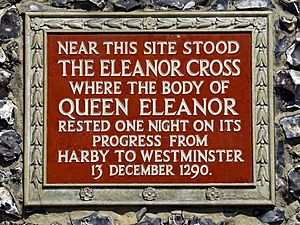
51°45′04″N 00°20′26″W / 51.75111°N 0.34056°W Eleanor's body rested in St Albans, Hertfordshire, on December 12, 1290. This cross was built between 1291 and 1293. It cost over £100. It stood at the south end of the Market Place, in front of the Clock Tower. It was described as "very stately" in 1596. However, it fell apart and was taken down in 1701–02. A ceramic plaque on the Clock Tower remembers the Eleanor cross.
Waltham Cross
51°41′09″N 00°01′59″W / 51.68583°N 0.03306°W Eleanor's body rested in Cheshunt, Hertfordshire, on December 13, 1290. This cross was built around 1291. It cost over £110. It became known as Waltham Cross because it was near Waltham Abbey. The cross is still standing today. It has been repaired many times, including in 1832–34, 1885–92, 1950–53, and 1989–90.
The original statues of Eleanor were very worn out. They were replaced with copies during the 1950s repairs. The original statues are now kept at the Victoria & Albert Museum.
Cheapside Cross (London)

51°30′51″N 00°05′41″W / 51.51417°N 0.09472°W Eleanor's body arrived in the City of London on December 14, 1290. A spot for the cross was chosen in Westcheap (now Cheapside). Her heart was buried at the Blackfriars priory. The Cheapside cross was built starting in 1291. It cost over £226.
The cross was repaired and redecorated many times. It was even covered in gold for coronations and royal visits. Over time, people started to see the cross as a problem. It blocked traffic, and pieces of stone would fall off. After the English Reformation, some people didn't like its Catholic images. Parts of it were damaged in 1581, 1599, and 1600–01.
Before the Civil War, the cross became a symbol of royal power. People who opposed the King wanted it gone. It was finally torn down on May 2, 1643. This event was an important part of destroying religious images in English history. Two pieces of the original cross were found in 1838. They are now at the Museum of London.
Charing Cross (Westminster)

51°30′26″N 00°07′39″W / 51.50722°N 0.12750°W Eleanor's body spent its last night, December 16, 1290, at Charing, Westminster. This was a few hundred yards from Westminster Abbey. This area later became known as Charing Cross. This cross was the most expensive of all twelve, costing over £700. It was built from 1291 onwards.
The cross stood near the Royal Mews, at the top of what is now Whitehall. It was described as the "most stately" of the crosses. However, by 1590, it was "weather-beaten." Parliament ordered it to be taken down in 1643, and it was finally destroyed in 1647.
After King Charles II returned to power, a statue of King Charles I was put up on the cross's site in 1675. This statue is still there today. The area is still called Charing Cross. Since the early 1800s, this spot has been seen as the official center of London.
A new Eleanor cross was built in 1865 outside Charing Cross railway station. This is a few hundred yards from where the original stood.
Some people think the name Charing comes from the French words chère reine, meaning "dear queen." But the name "Charing" was used for the area before Eleanor died. It probably comes from an old Anglo-Saxon word meaning "a bend," because it's on a sharp bend in the River Thames.
Newer Crosses and Copies
Many Eleanor crosses, or monuments that looked like them, were built in the 1800s and early 1900s.
- The cross at Ilam, Staffordshire, was built in 1840 to remember a wife.
- The Martyrs' Memorial in Oxford was built in 1841–43. It remembers people who died for their beliefs in the 1500s.
- The Glastonbury Market Cross, Somerset, was built in 1846.
- Banbury Cross, Oxfordshire, was built in 1859. It celebrated the marriage of Queen Victoria's daughter.
- The Queen Eleanor Memorial Cross at Charing Cross in London was built in 1865. It stands outside Charing Cross railway station. It's taller and fancier than the original. It was built for the new Charing Cross Hotel. It was largely restored in 2009–10.
- The Ellesmere Memorial at Walkden, Lancashire, was built in 1868 to remember a countess.
- The Albert Memorial, in Kensington Gardens, London, was opened in 1872. Queen Victoria had it built for her husband, Prince Albert. It's much bigger than the Eleanor crosses, but it was inspired by them.
- The Loudoun Monument, Ashby-de-la-Zouch, Leicestershire, was built in 1879 to remember a countess.
- The Sledmere Cross was built in Sledmere, East Riding of Yorkshire, in 1896–98. It later became a war memorial.
- The Queen Victoria Monument, Birkenhead, Merseyside, was unveiled in 1905.
- A modern monument inspired by the lost medieval cross was built in Stamford in 2009. It stands in Sheepmarket, not the original spot.
Gallery
-
Glastonbury Market Cross, 1846
-
Banbury Cross, 1859
-
Charing Cross, London, 1865
-
Albert Memorial, London, 1872
-
Sledmere Cross, 1896
See also
 In Spanish: Cruces de Leonor para niños
In Spanish: Cruces de Leonor para niños


